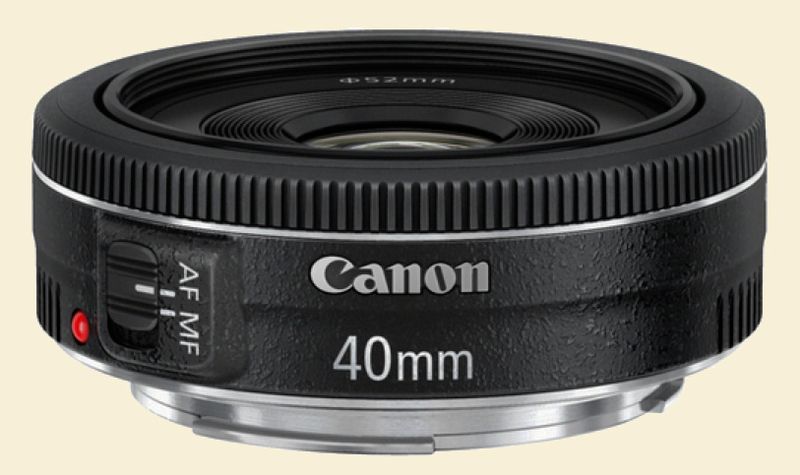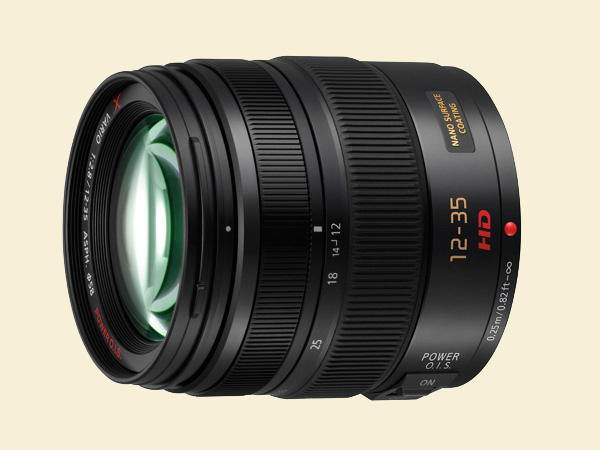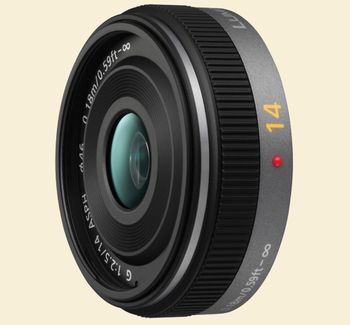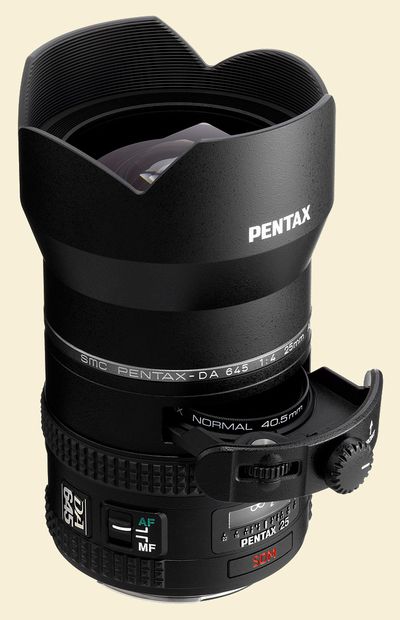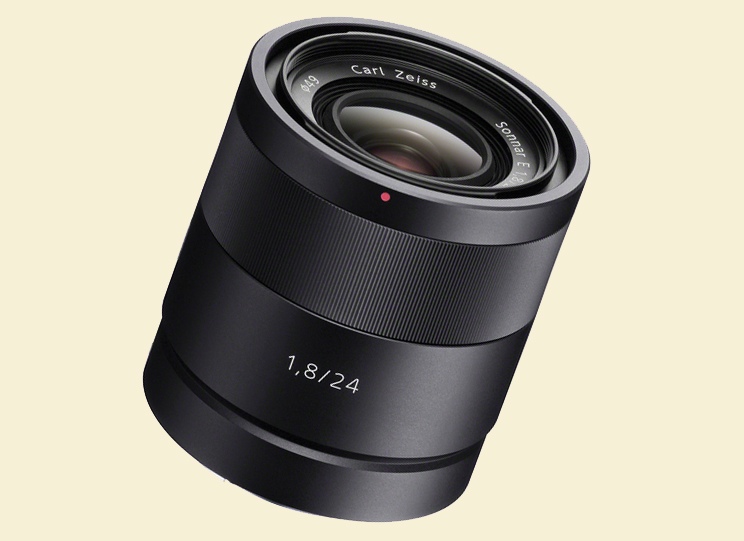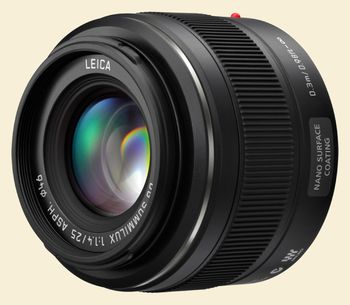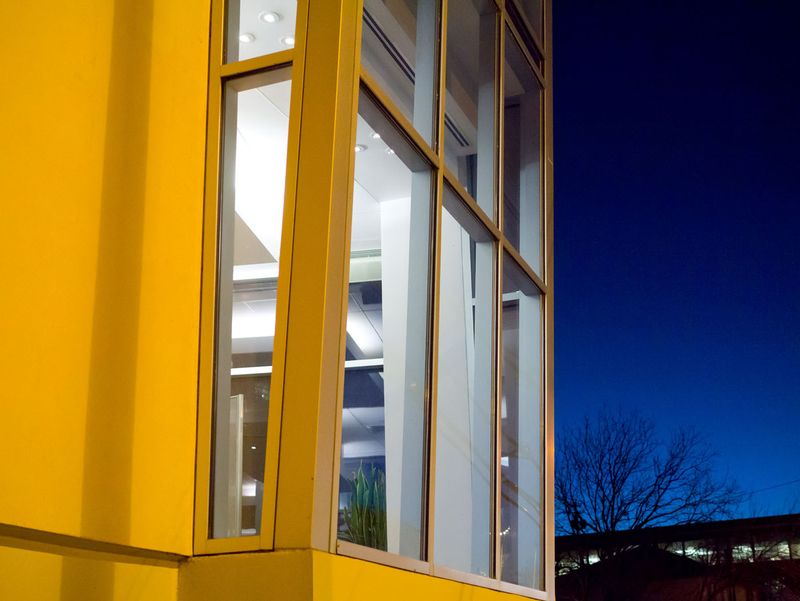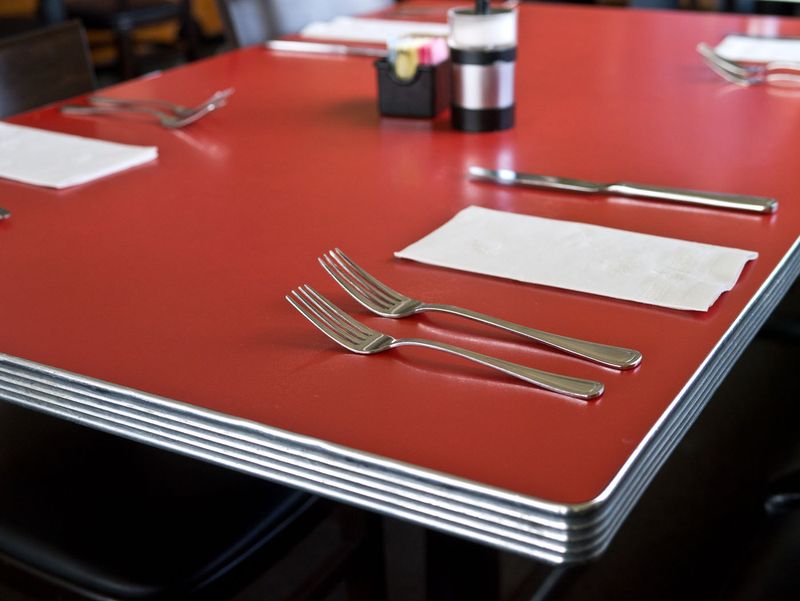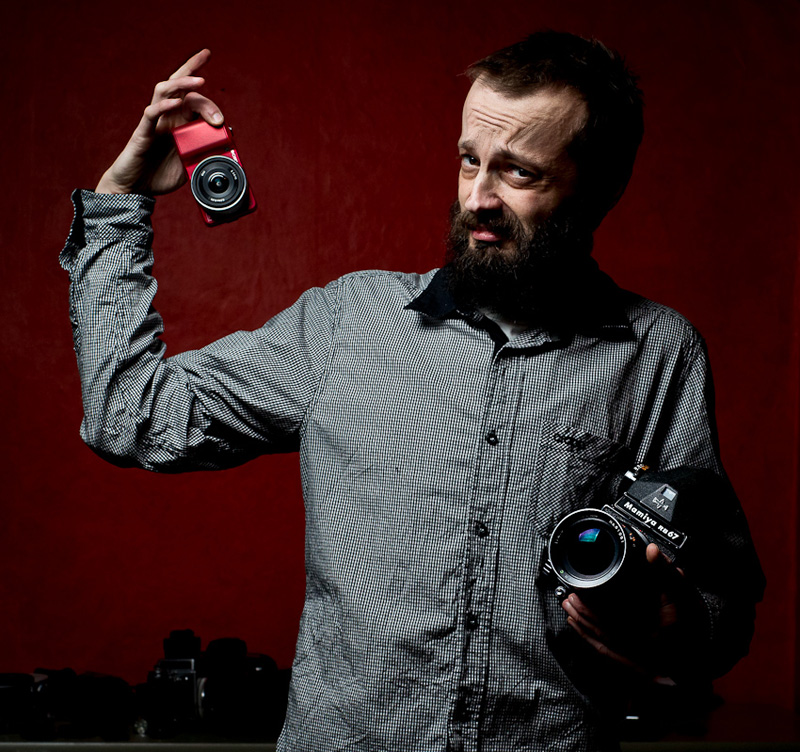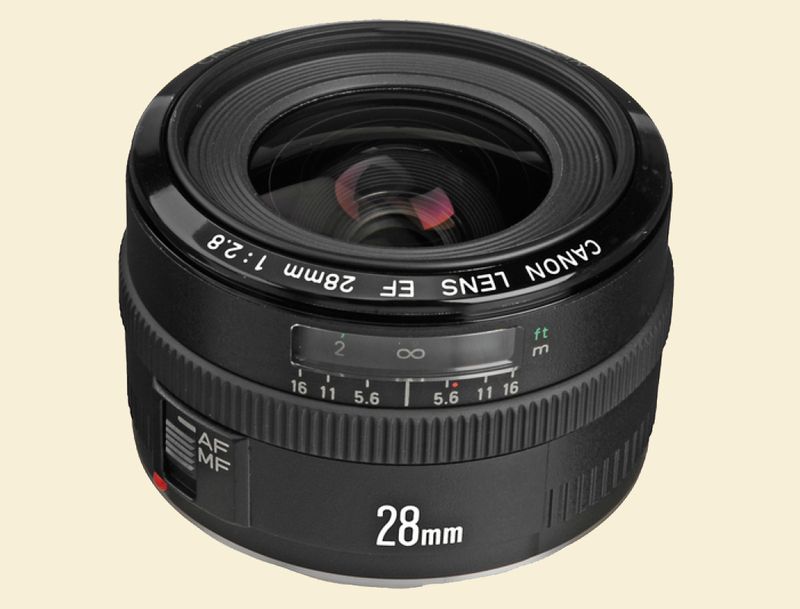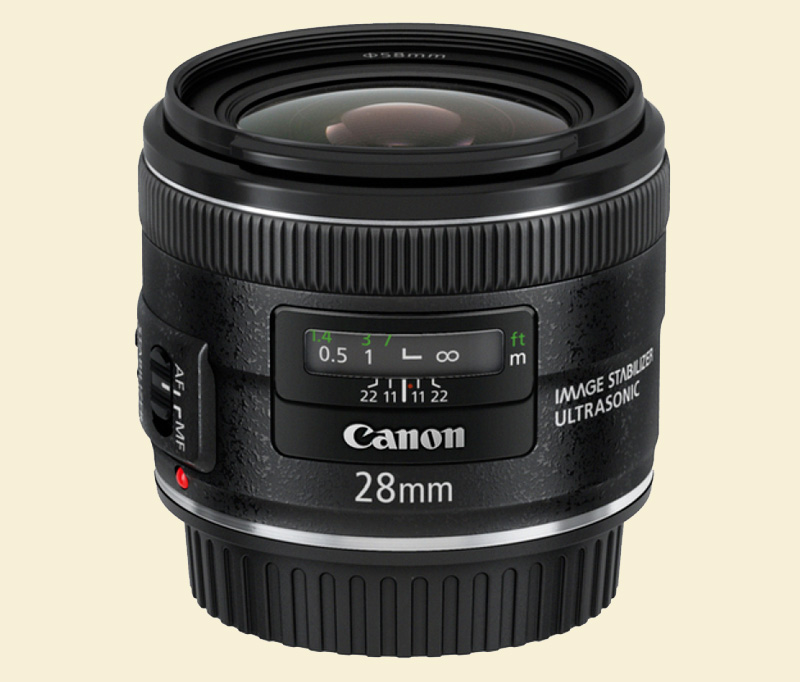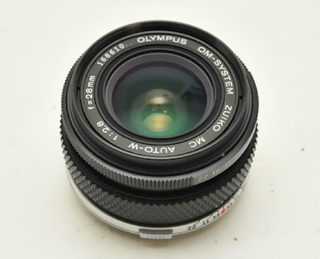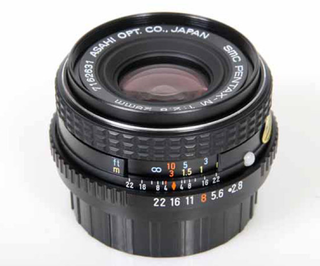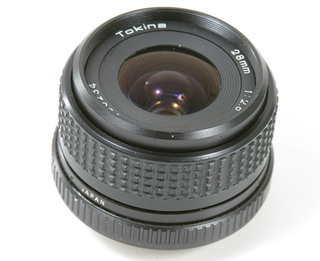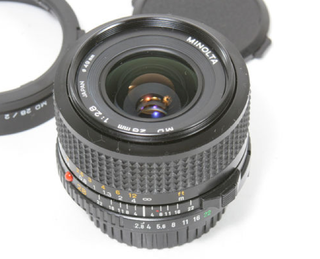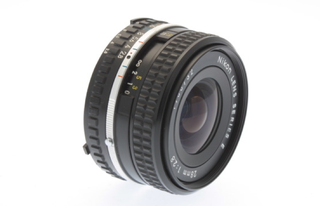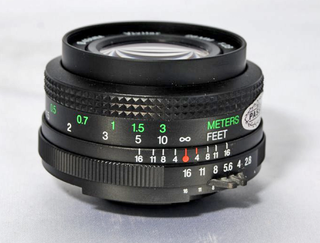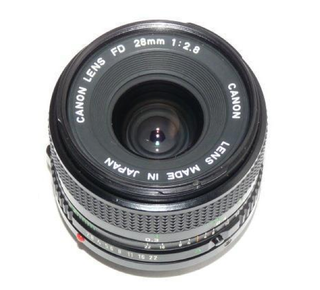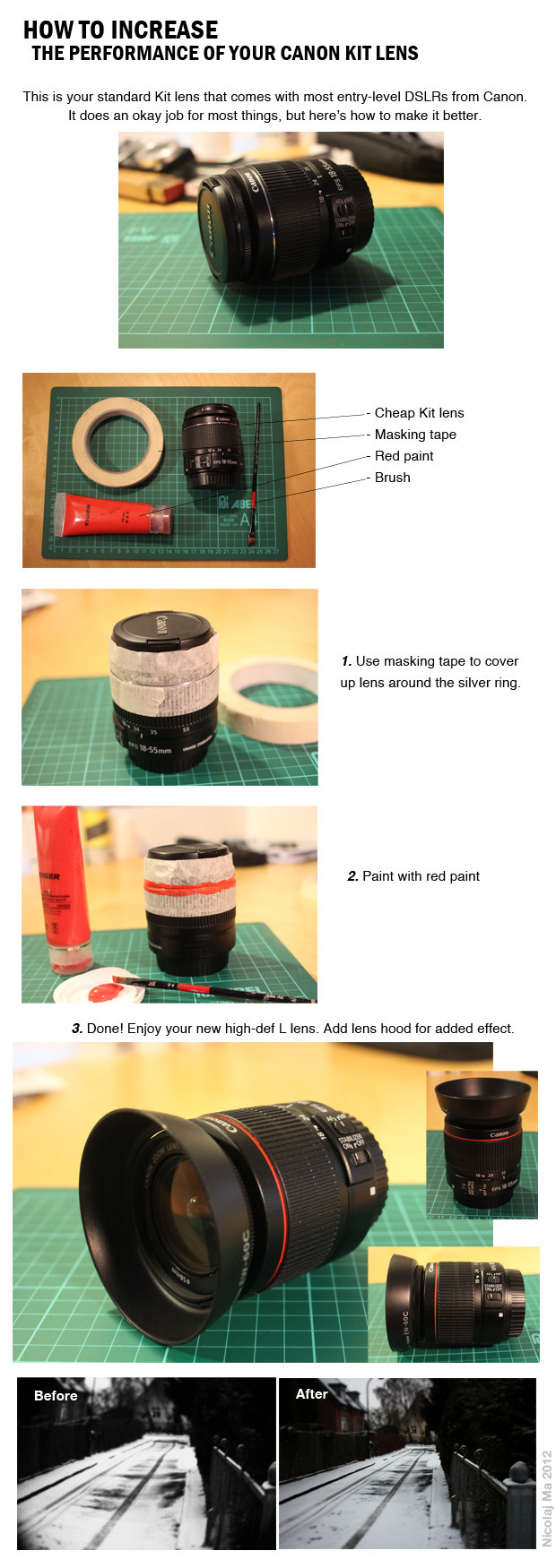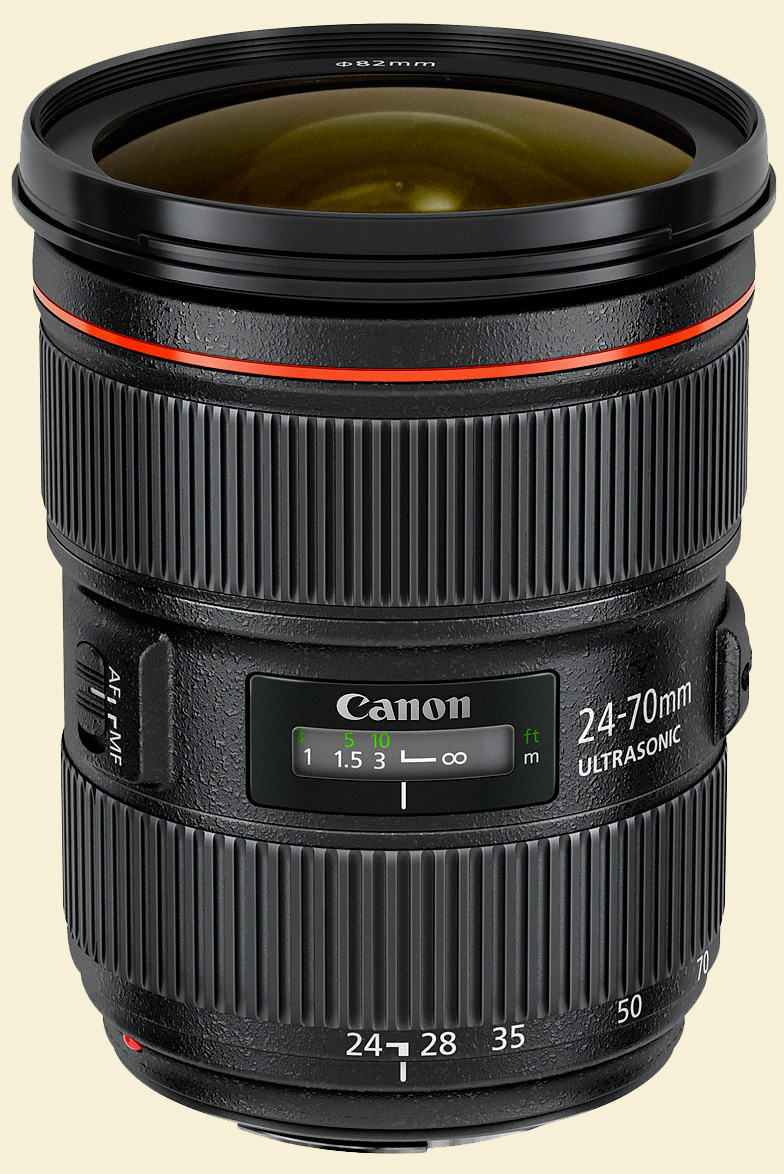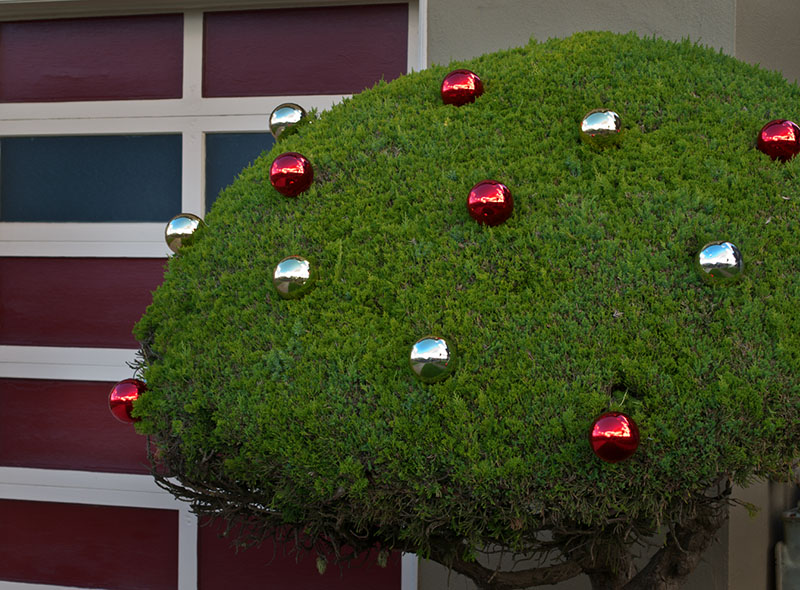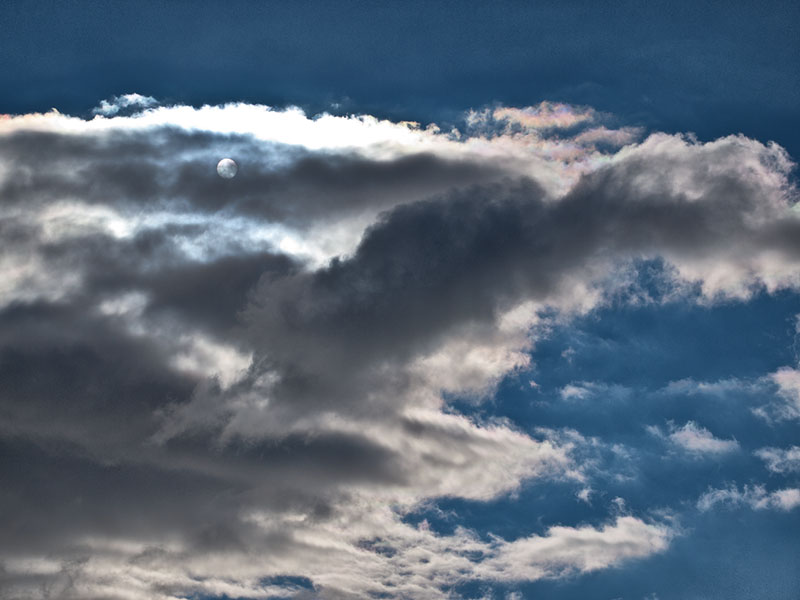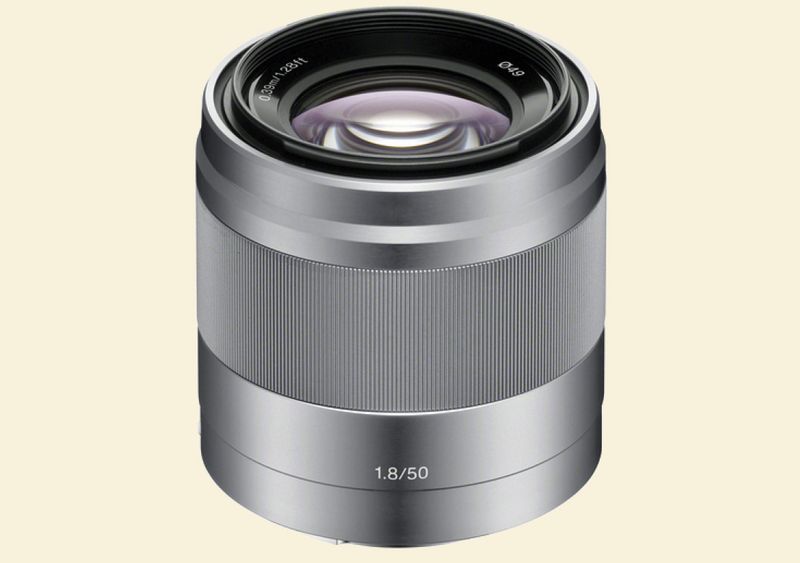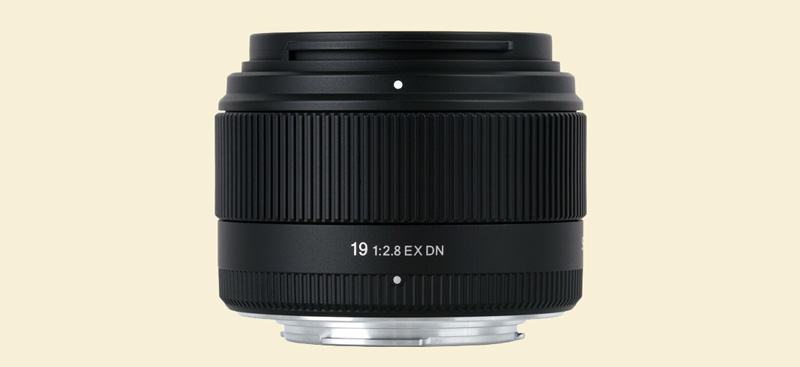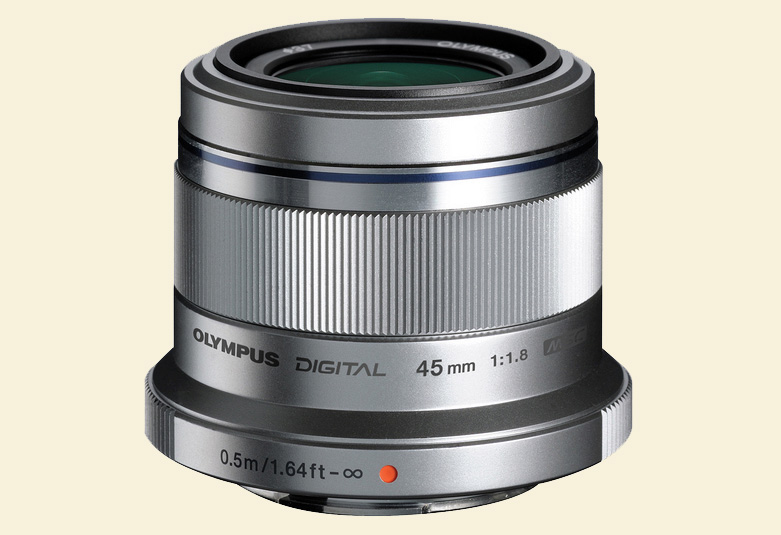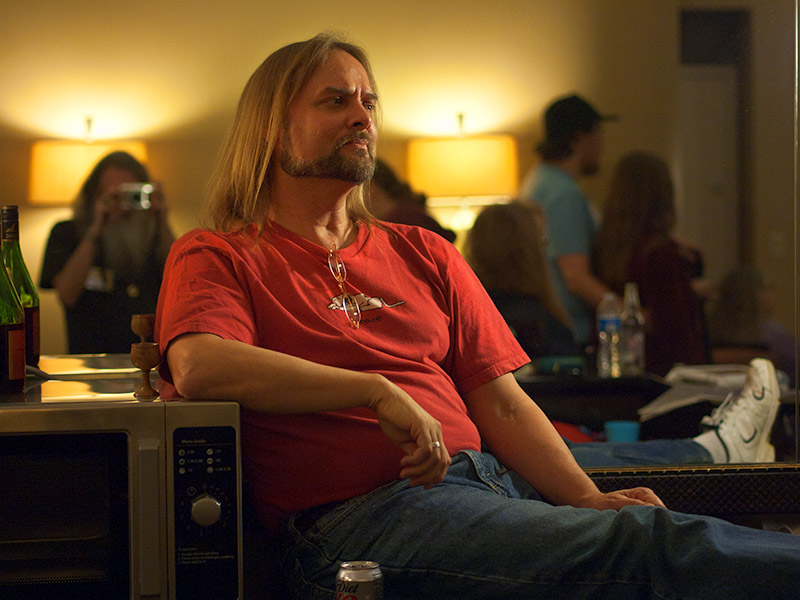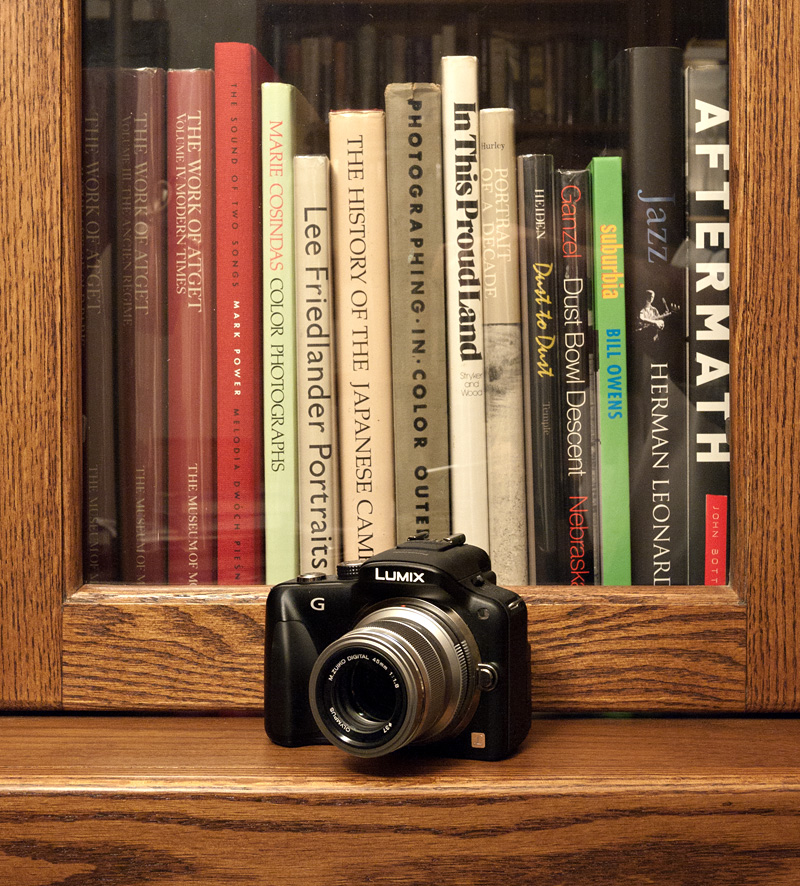By Ctein
"You get what you pay for."
This bit of anti-consumerism is frequently trotted out as an excuse for high prices, as if it were some law of nature. It's not. Sometimes you get a lot more than what you pay for. Sometimes you get a lot less.
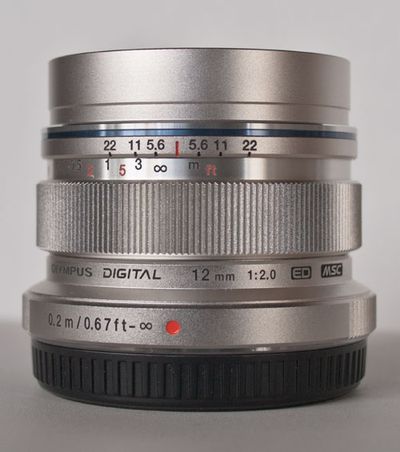 The Olympus 12mm Micro 4/3 lens, with the focus ring pulled down
The Olympus 12mm Micro 4/3 lens, with the focus ring pulled down
to reveal the distance and depth of field scales.
At $800, the Olympus M. Zuiko Digital ED 12mm ƒ/2 lens is a case of getting less. A lens this pricey should be great; this 12mm (equivalent to 24mm in full frame format) has too many warts and weak spots to qualify as anything more than good. Its deficiencies are serious enough that I strongly considered returning it.
The main reason I didn't is that it occupies a unique spot in the lens selection for Micro 4/3. Fast wide angles are rare; the closest competitor I know of is the Panasonic 14mm ƒ/2.5. I have the Olympus 14–42 mm kit lens, and it's a better lens than most people give it credit for. I didn't need another 14mm lens just to gain a stop. I did hanker for something wider, but, because I'm not a major wide-angle fan, I didn't yearn for one of those small-aperture, large-size wide-angle zooms.
Truth is I was looking forward to this lens almost as much as the 45mm ƒ/1.8 I reviewed last week. It would fill a conspicuous hole at the end of my focal length range, and its fast aperture would let me use it for available light work as well as nature photography, my primary activity.
The first thing I did with the lens after I got it from B&H was take it out for some field tests. When I pulled the photographs up on my computer, I was sorely disappointed. On-axis sharpness was only adequate, even at ƒ/4.5–ƒ/8. Not good. Worse, edge quality stayed mediocre at all apertures (below). I don't expect great edge quality from a 24mm-equivalent at ƒ/2. I do when it's stopped down several stops, at least if it costs as much as this lens does.
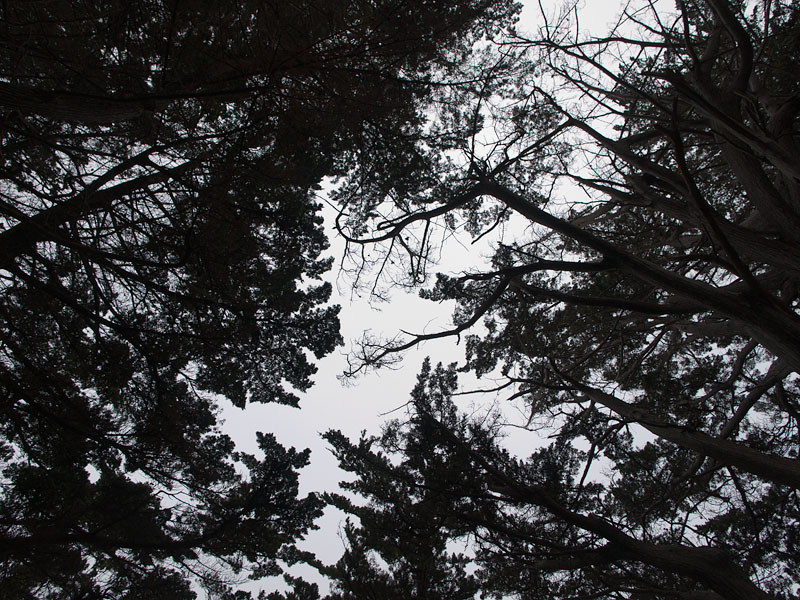 This photo was made at ƒ/4.5 with my first sample of the lens. Shown below are the central and corner portions at 100% scale.
This photo was made at ƒ/4.5 with my first sample of the lens. Shown below are the central and corner portions at 100% scale.
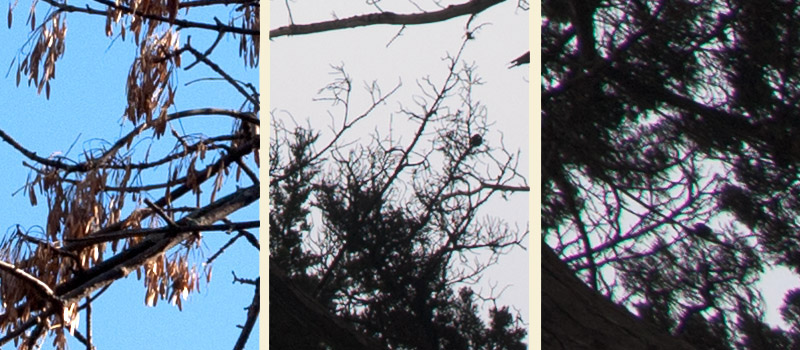 Click to open 100% sections of RAW files, converted using my ACR defaults. On the left is the central portion of a photograph made at ƒ/5.6 with the Olympus 45mm ƒ/1.8 lens for comparison. By comparison, the central portion of a photograph made at ƒ/4.5 with the 12mm lens looks very soft (middle). Corner performance (right) shows clear smearing. Stopping the 12mm lens down further did not significantly improve image quality.
Click to open 100% sections of RAW files, converted using my ACR defaults. On the left is the central portion of a photograph made at ƒ/5.6 with the Olympus 45mm ƒ/1.8 lens for comparison. By comparison, the central portion of a photograph made at ƒ/4.5 with the 12mm lens looks very soft (middle). Corner performance (right) shows clear smearing. Stopping the 12mm lens down further did not significantly improve image quality.
Allowing for the possibility that my expectations were unrealistic, I ran this past TOP's panel of experts. There was a general agreement that this was not stellar performance and that there was a fair chance I had a defective lens. Jeff Goggin, who already owned a 12mm, sent me a JPEG of one of his photos that looked a lot better than any of mine.
I exchanged my lens for a new one. The new one was a lot better. Center sharpness was very good wide open, and became excellent stopped down. Edge quality? Well, it still wasn't particularly good wide open, but I would not expect that from a 12mm ƒ/2 lens at any price. It got a lot better stopped down than my first sample did, but it never got great. Most important for me, it was only marginally acceptable in 15x20" image area prints. That's my standard size for sale. It's pushing what this camera can do, but my other lenses perform well there. This lens makes the grade, but only barely, and you better not be looking too closely at those corners:
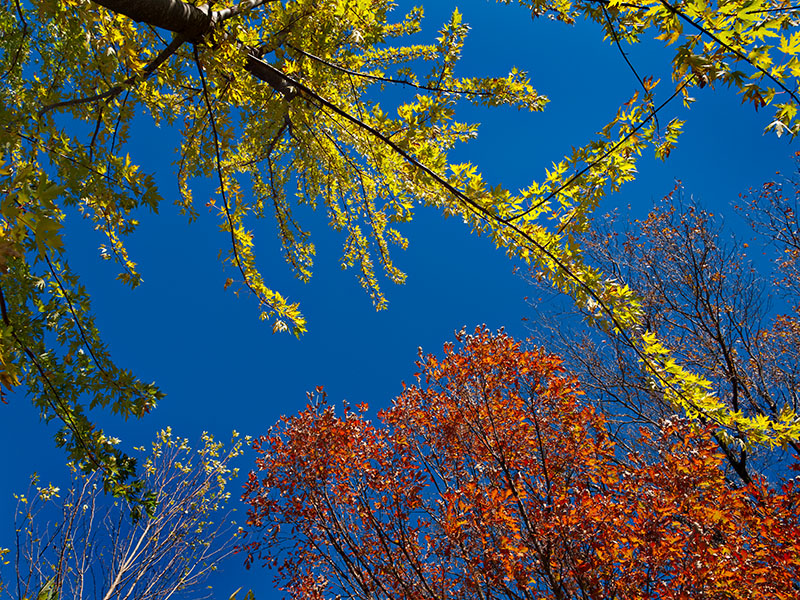 A second sample of the 12mm lens performed much better. Please note this is not a straight RAW conversion; this is a print-ready file I worked magic on in Photoshop. It illustrates the best sharpness and fine detail I can extract from this lens.
A second sample of the 12mm lens performed much better. Please note this is not a straight RAW conversion; this is a print-ready file I worked magic on in Photoshop. It illustrates the best sharpness and fine detail I can extract from this lens.
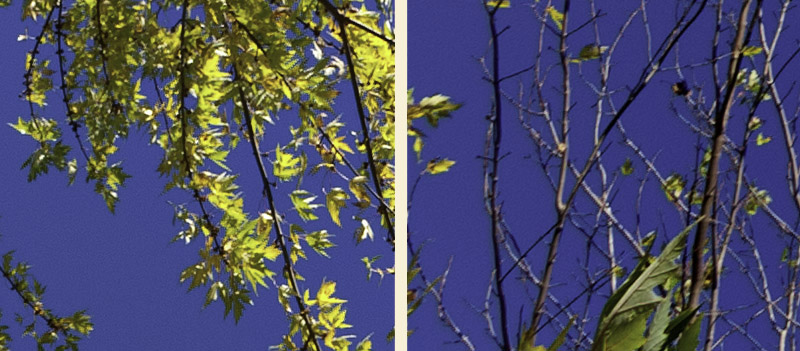 100% sections of the center and corner illustrate that central performance is excellent, but the corners still show some smear, even at ƒ/7.
100% sections of the center and corner illustrate that central performance is excellent, but the corners still show some smear, even at ƒ/7.
$800 should get me better optical quality than that.
One much-touted feature of this lens is full manual focusing. Pull back on the knurled focusing ring and it reveals a distance and depth of field scale. The focusing ring no longer free-wheels as it does in normal manual focus mode; it locks into place so that you can manually focus this lens like an ordinary camera lens. A very nice idea when you need to focus quickly; scale focusing is a valuable technique with wide-angle lenses, which benefit from generous depth of field. Fixed-position focusing rings are also easier to use than the free-wheeling kind; you quickly develop tactile feedback that lets you focus very quickly in situations where autofocus won't cut it.
Olympus's implementation of this has three big problems:
- The focusing ring focuses well past infinity. The end stop is at about +ƒ/4 (I'm using the depth of field marks as indicators). You can't blindly set the lens to infinity, or you'll actually be focused well beyond infinity. This kind of slop is often needed with telephoto lenses to allow for thermal expansion, but that shouldn't be an issue with a 12mm lens.
- If you align the infinity mark with the focus line, you're still not in focus at infinity. True infinity focus is when the infinity mark is at about –ƒ/2.8. Consequently, scale focusing isn't going to be very accurate.
- When you focus in this full manual mode you don't get continuous focusing, as you do in normal manual focusing where the ring free-wheels. The manual ring only provides coarse zone focusing. Focus snaps from zone to zone abruptly; the separation between zones is about the same as the separation between the focus line and the ƒ/5.6 mark. That huge jump makes it impossible to achieve either precise or accurate focus.
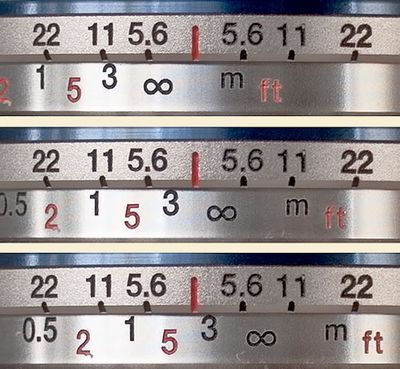
Full manual focus is poorly implemented. The top close-up shows the position of the distance scale when the focusing ring is turned to the full left; the lens is actually focused well beyond infinity. The middle illustration shows the ring's position at the point of best infinity focus; the infinity mark is well off the distance indicator. The lower illustration shows how much more the focusing ring needs to be rotated to change the focus by a single zone. That is a very large jump in focus.
I began to wonder if I might not have another defective lens. Jeff graciously loaned me his copy. The results are reminiscent of good news/bad news jokes:
Our two lenses perform essentially identically, so the good news is that I didn't get a second defective lens.
The bad news is that this isn't a defective lens. This seems to be as good as it gets.
Actual good news
Unexceptional image quality and an amazingly awful manual focus ring. Is there anything I can wholeheartedly praise in this lens? Yes: image stabilization.
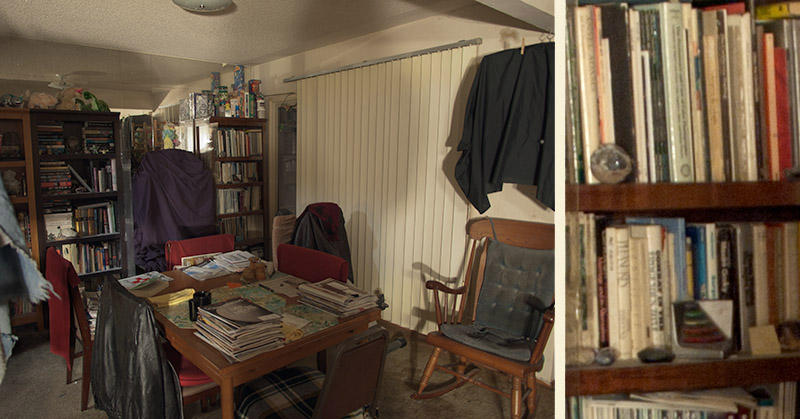 This lens shines at available light work. I made this photograph handheld at ISO 100 at ƒ/2 with an exposure time of 2/3 second. There was no light on in the dining room; the only sources of illumination were lights in other rooms. It is actually much darker in there than normal dim indoor lighting. Note how little blur there is in the 100% section on the right.
This lens shines at available light work. I made this photograph handheld at ISO 100 at ƒ/2 with an exposure time of 2/3 second. There was no light on in the dining room; the only sources of illumination were lights in other rooms. It is actually much darker in there than normal dim indoor lighting. Note how little blur there is in the 100% section on the right.
This lens is so stable that I would swear the image stabilization system in the Olympus EP-1 had been designed around it. I can handhold this lens at 1/4th second and get photos that are sharp down to the single pixel level three-quarters of the time. At 1/2 second I'm good half to a third of the time. On rare occasion, when the gods smile, I can push even further (above), although a full second seems beyond my capabilities.
If I crank the ISO up to 800 (the maximum ISO for high quality with this camera), the results become amazing, as you can see below. If I can see it, I can photograph it (assuming, of course, that "it" is standing stock still).
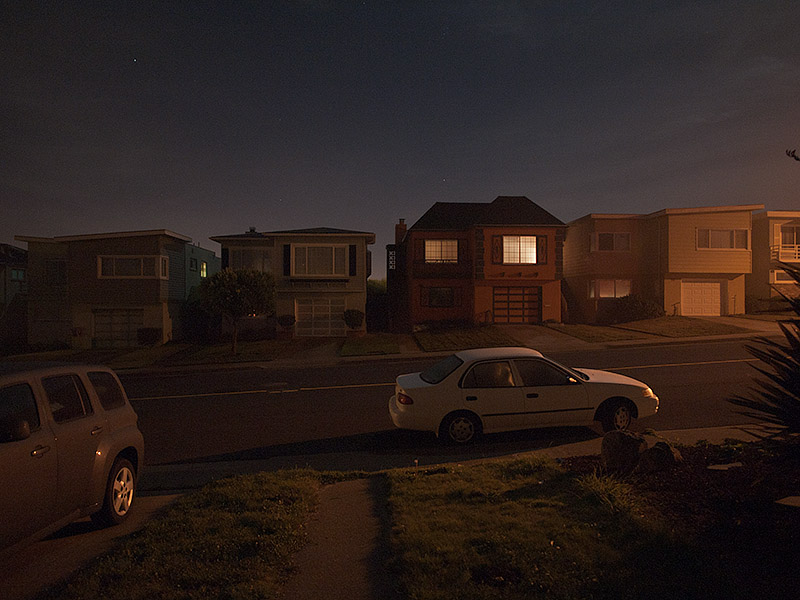 ISO 800 at ƒ/2 and 1/2 second, handheld. It's the middle of the night; the only illumination is a street lamp up the road and the ubiquitous urban night sky illumination. The white spots in the sky aren't hot pixels, they are stars.
ISO 800 at ƒ/2 and 1/2 second, handheld. It's the middle of the night; the only illumination is a street lamp up the road and the ubiquitous urban night sky illumination. The white spots in the sky aren't hot pixels, they are stars.
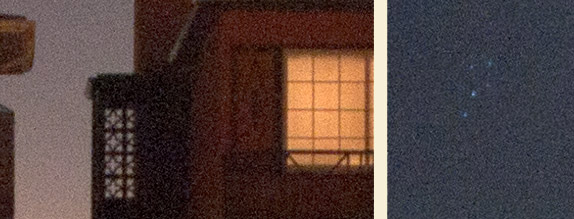 100% sections from the frame above, showing how rock-steady the image it is. The faint white dots on the right? Those are the Pleiades! They're just barely visible in the full frame, near the top center of the frame.
100% sections from the frame above, showing how rock-steady the image it is. The faint white dots on the right? Those are the Pleiades! They're just barely visible in the full frame, near the top center of the frame.
For available light work, this lens is a true champion, due to its combination of acceptable wide-open image quality and unbelievable stability. Under more normal conditions, the lens is less impressive. This is not a bad lens. But it is no better than merely good, and its performance doesn't come anywhere close to justifying an $800 price tag.
For the present time, I'm keeping it. If a better fast wide-angle comes along, I won't hesitate to replace this lens. It is only its uniqueness that makes it a keeper for me.
Ctein
Olympus 12mm ƒ/2 from B&H Photo
Olympus 12mm ƒ/2 from Amazon.com
Olympus 12mm ƒ/2 from Amazon U.K.
Ctein's regular weekly column appears every Wednesday on TOP.
Send this post to a friend
Please help support TOP by patronizing our sponsors B&H Photo and Amazon
Note: Links in this post may be to our affiliates; sales through affiliate links may benefit this site. More...
Original contents copyright 2011 by Michael C. Johnston and/or the bylined author. All Rights Reserved.
Featured Comment by Jeffrey Goggin: "While I agree with most of what Ctein says about this lens factually, I disagree with him a bit as to a few of his subjective statements of opinion.
"For a start, $800 doesn’t strike me as ridiculously expensive for a lens, at least not these days. I have paid quite a bit more than that for several of them over the past three years, including the Olympus 4/3-format 7–14mm and 14–35mm zooms I happily use with my E-P1 and other Micro 4/3 bodies, and I personally consider the 12mm ƒ/2 lens to offer good—but not great—value for the money.
"Second, the maximum size print that I can make from the average Micro 4/3 file is 12x16", slightly less than two-thirds the size of Ctein’s preferred 15x20" prints. At that larger size, I am not surprised that he is less than delighted with E-P1/12mm combo’s image quality overall, but at 12x16, I find that I am generally satisfied with the quality of the results that I achieve with it.
"Third, the various focusing quirks he cites, while definitely annoying in theory, don’t seem to be nearly so annoying in practice. At least not to me; your mileage may vary, of course.
"However, I do agree that the E-P1/12mm combo handles handheld, low-light photography with considerable aplomb. Last summer, I used mine to photograph handheld inside the underground parking garage at the office building where I work and was amazed to find I could consistently capture sharp photos using shutter speeds in the 1/8 to 1/2 second range, especially when I would hold the shutter button down and capture batches of three images consecutively, as the middle one almost always proved to be slightly sharper than the other two.
"Bottom line: If you’re considering purchasing this lens, I suggest that you check it out personally and decide for yourself whether it meets your needs and/or fits your budget, rather than rely solely upon the opinions of others. And I suspect Ctein will agree with me on this point."
Featured Comment by Christina Brandon: "For those of you who haven't tried the 12mm ƒ/2, don't put your wallets away too hastily. I have had every wide-angle lens for the 4/3 and m4/3 formats—the $1800 7–14mm ƒ/4 lens (for 4/3); the $890 7–14mm ƒ/4 lens (for m4/3); the $600 9–18mm ƒ/4–5.6 lens (for 4/3) and the $700 9–18mm ƒ/4–5.6 lens (for m4/3)—and this is hands-down my favorite of the bunch.
"I have had the 12mm ƒ/2 lens since July and to say I am blown away by it is an understatement. As somewhat out-of-control collectors of cameras and lenses, my husband and I have plenty of other gear for comparison, including a Nikon D3 setup, a Canon 5DMII, and lots of truly stellar manual focus legacy glass we use on the Sony NEX 5n. We both agree that this little 12mm is a gem on all fronts.
"Here's what's great about it:
- Image quality—By far the most important aspect of a lens to me is its image quality. Over the four months or so I've been using this lens, it has delivered consistently sharp, contrasty images under a wide variety of shooting conditions and with an equally wide variety of subjects, from portraits to architectural interiors. It's one of those lenses I feel I can depend on to give me not just good images but truly special images.
- Wide aperture—I love this lens for interiors in available light, and guess what—an ƒ/4 or ƒ/4–5.6 lens is not much fun to use in low light. An ƒ/2 lens makes all the difference, and it's so sharp wide open that I find myself using it at ƒ/2 for the majority of my shots.
- Minimum focusing distance—It's closer-focusing than any of the other wide and ultra-wide angle lenses I listed above (20 cm vs. 25 cm). This is a big deal for me as I enjoy getting in close to many of my subjects. Not only that, but an added benefit of getting in so close is that at ƒ/2 the backgrounds can be thrown significantly out of focus.
- Aesthetics and ergonomics—Nothing to forgive here, either! This is truly a beautiful lens to hold, use, and just gaze at.
"Do I think the $800 price tag is appropriate? You bet I do. The lenses I listed above range from $600 to $1800. The only cheaper lens is the $600 9–18mm for 4/3, and I really struggled to get sharp images with that lens, so much so that I sold it. And of course all of those other lenses are ƒ/4 or slower! I consider it a minor miracle to have such a beautiful, tiny, jewel of a lens that is both super sharp and super fast for less than $1000.
"I am scratching my head a bit about Ctein's experience with edge sharpness. I get consistent sharpness across the frame at all apertures with this lens. I can't speak to the manual focus issues he discusses, as I've only shot it in autofocus mode.
"By the way, I have the 45mm ƒ/1.8 lens as well, and while that lens is also excellent and the 'right' focal length for my way of seeing most of the time, I have to say that the 12mm would be the harder of the two to part with if I had to make a choice. It's that special."
